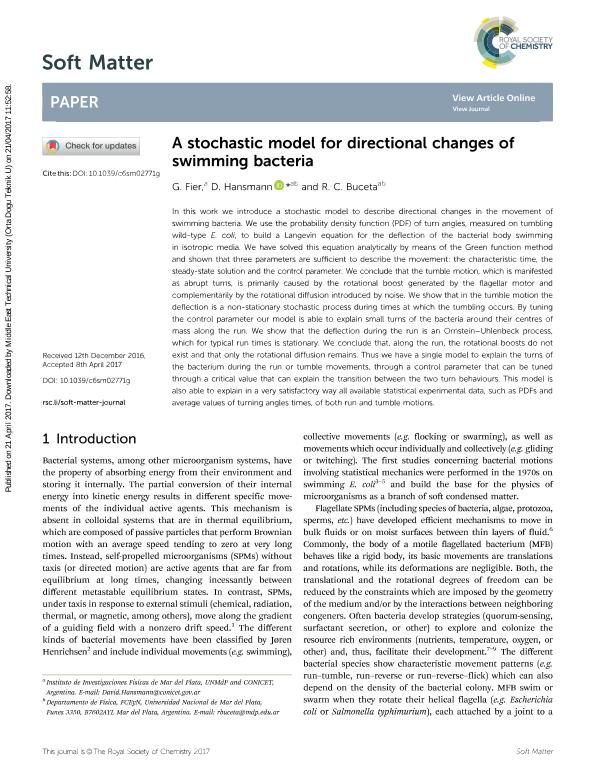Mostrar el registro sencillo del ítem
dc.contributor.author
Fier, Guido

dc.contributor.author
Hansmann, David

dc.contributor.author
Buceta, Ruben Carlos

dc.date.available
2018-12-06T14:01:45Z
dc.date.issued
2017-04-17
dc.identifier.citation
Fier, Guido; Hansmann, David; Buceta, Ruben Carlos; A stochastic model for directional changes of swimming bacteria; Royal Society of Chemistry; Soft Matter; 13; 18; 17-4-2017; 3385-3394
dc.identifier.issn
1744-683X
dc.identifier.uri
http://hdl.handle.net/11336/65965
dc.description.abstract
In this work we introduce a stochastic model to describe directional changes in the movement of swimming bacteria. We use the probability density function (PDF) of turn angles, measured on tumbling wild-type E. coli, to build a Langevin equation for the deflection of the bacterial body swimming in isotropic media. We have solved this equation analytically by means of the Green function method and shown that three parameters are sufficient to describe the movement: the characteristic time, the steady-state solution and the control parameter. We conclude that the tumble motion, which is manifested as abrupt turns, is primarily caused by the rotational boost generated by the flagellar motor and complementarily by the rotational diffusion introduced by noise. We show that in the tumble motion the deflection is a non-stationary stochastic process during times at which the tumbling occurs. By tuning the control parameter our model is able to explain small turns of the bacteria around their centres of mass along the run. We show that the deflection during the run is an Ornstein-Uhlenbeck process, which for typical run times is stationary. We conclude that, along the run, the rotational boosts do not exist and that only the rotational diffusion remains. Thus we have a single model to explain the turns of the bacterium during the run or tumble movements, through a control parameter that can be tuned through a critical value that can explain the transition between the two turn behaviours. This model is also able to explain in a very satisfactory way all available statistical experimental data, such as PDFs and average values of turning angles times, of both run and tumble motions.
dc.format
application/pdf
dc.language.iso
eng
dc.publisher
Royal Society of Chemistry

dc.rights
info:eu-repo/semantics/openAccess
dc.rights.uri
https://creativecommons.org/licenses/by-nc-sa/2.5/ar/
dc.subject
Swimming Bacteria
dc.subject
Run-And-Tumble
dc.subject
Turning Motion
dc.subject
Directional Changes
dc.subject
E. Coli
dc.subject
Langevin Equation
dc.subject
Stochastic Behaviour
dc.subject.classification
Física Atómica, Molecular y Química

dc.subject.classification
Ciencias Físicas

dc.subject.classification
CIENCIAS NATURALES Y EXACTAS

dc.title
A stochastic model for directional changes of swimming bacteria
dc.type
info:eu-repo/semantics/article
dc.type
info:ar-repo/semantics/artículo
dc.type
info:eu-repo/semantics/publishedVersion
dc.date.updated
2018-10-23T14:08:37Z
dc.journal.volume
13
dc.journal.number
18
dc.journal.pagination
3385-3394
dc.journal.pais
Reino Unido

dc.journal.ciudad
Cambridge
dc.description.fil
Fil: Fier, Guido. Consejo Nacional de Investigaciones Científicas y Técnicas. Centro Científico Tecnológico Conicet - Mar del Plata. Instituto de Investigaciones Físicas de Mar del Plata. Universidad Nacional de Mar del Plata. Facultad de Ciencias Exactas y Naturales. Instituto de Investigaciones Físicas de Mar del Plata; Argentina
dc.description.fil
Fil: Hansmann, David. Consejo Nacional de Investigaciones Científicas y Técnicas. Centro Científico Tecnológico Conicet - Mar del Plata. Instituto de Investigaciones Físicas de Mar del Plata. Universidad Nacional de Mar del Plata. Facultad de Ciencias Exactas y Naturales. Instituto de Investigaciones Físicas de Mar del Plata; Argentina. Universidad Nacional de Mar del Plata. Facultad de Ciencias Exactas y Naturales. Departamento de Física; Argentina
dc.description.fil
Fil: Buceta, Ruben Carlos. Consejo Nacional de Investigaciones Científicas y Técnicas. Centro Científico Tecnológico Conicet - Mar del Plata. Instituto de Investigaciones Físicas de Mar del Plata. Universidad Nacional de Mar del Plata. Facultad de Ciencias Exactas y Naturales. Instituto de Investigaciones Físicas de Mar del Plata; Argentina. Universidad Nacional de Mar del Plata. Facultad de Ciencias Exactas y Naturales. Departamento de Física; Argentina
dc.journal.title
Soft Matter

dc.relation.alternativeid
info:eu-repo/semantics/altIdentifier/url/https://pubs.rsc.org/en/Content/ArticleLanding/2017/SM/C6SM02771G
dc.relation.alternativeid
info:eu-repo/semantics/altIdentifier/doi/https://dx.doi.org/10.1039/C6SM02771G
Archivos asociados
